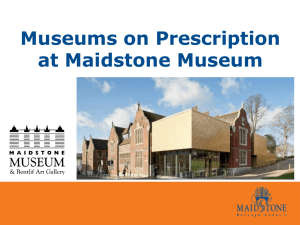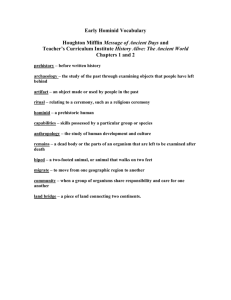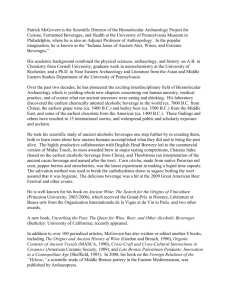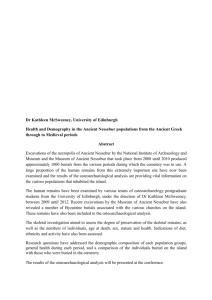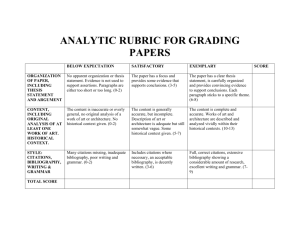Library Undergraduate Research Award Essay 2014 Chiara Tondi Resta
advertisement
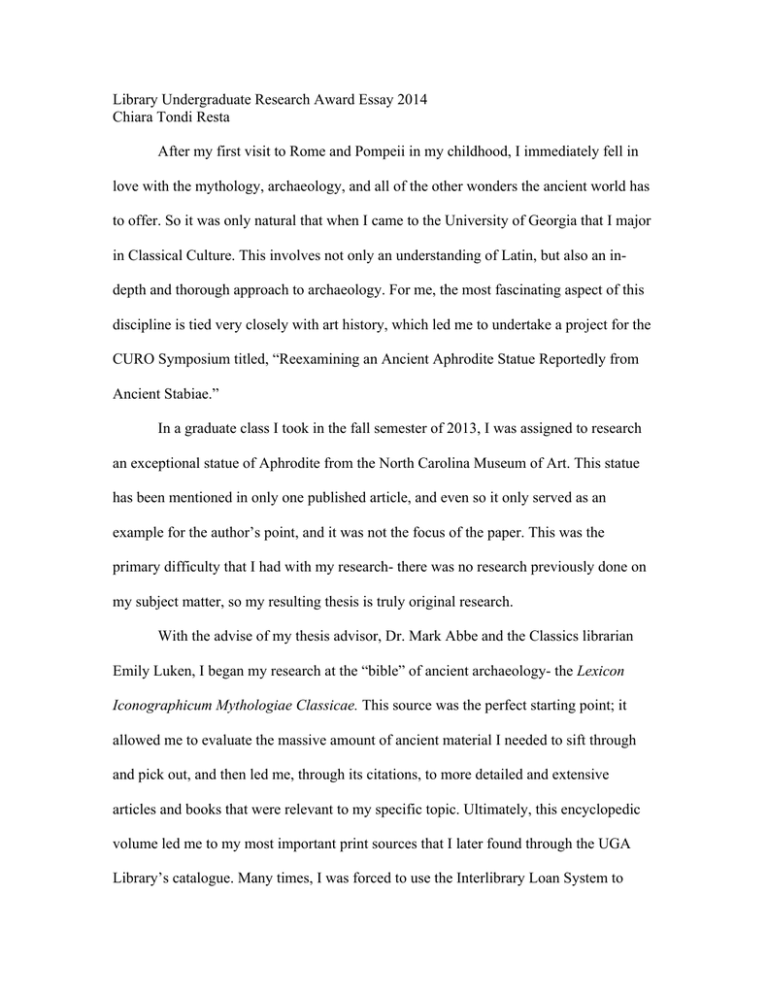
Library Undergraduate Research Award Essay 2014 Chiara Tondi Resta After my first visit to Rome and Pompeii in my childhood, I immediately fell in love with the mythology, archaeology, and all of the other wonders the ancient world has to offer. So it was only natural that when I came to the University of Georgia that I major in Classical Culture. This involves not only an understanding of Latin, but also an indepth and thorough approach to archaeology. For me, the most fascinating aspect of this discipline is tied very closely with art history, which led me to undertake a project for the CURO Symposium titled, “Reexamining an Ancient Aphrodite Statue Reportedly from Ancient Stabiae.” In a graduate class I took in the fall semester of 2013, I was assigned to research an exceptional statue of Aphrodite from the North Carolina Museum of Art. This statue has been mentioned in only one published article, and even so it only served as an example for the author’s point, and it was not the focus of the paper. This was the primary difficulty that I had with my research- there was no research previously done on my subject matter, so my resulting thesis is truly original research. With the advise of my thesis advisor, Dr. Mark Abbe and the Classics librarian Emily Luken, I began my research at the “bible” of ancient archaeology- the Lexicon Iconographicum Mythologiae Classicae. This source was the perfect starting point; it allowed me to evaluate the massive amount of ancient material I needed to sift through and pick out, and then led me, through its citations, to more detailed and extensive articles and books that were relevant to my specific topic. Ultimately, this encyclopedic volume led me to my most important print sources that I later found through the UGA Library’s catalogue. Many times, I was forced to use the Interlibrary Loan System to retrieve these sources, sometimes coming from as far as Illinois. Although these sources were indispensible in my research, having to use books that came from places other than UGA forced me to organize and plan out my research much more strictly, since I could only have the books for a limited amount of time. Once I started using each loaned book to the fullest very quickly though, I applied that practice to all of my sources, and soon found that I had learned how best to use my time with each individual text. Of course, as a twenty-first century student, I could not simply be satisfied with using only print sources. I consulted with Dr. Abbe and Ms. Luken to evaluate what were the best electronic databases to find articles and, of course, high quality images that I needed for my thesis. GALILEO, WORLDCAT, JSTOR, ARTstor, Art Resource, and Art Source proved to be the best. Here, by refining my searches based on information I had found in other reliable sources, such as through footnotes and bibliographies, I was able to find some of the most current and up-to-date articles by authors from around the world. Most of these articles came from reputable journals such as the American Journal of Archaeology, one of the leading archaeology journals in the world. All of these articles I knew were held to the highest scholarly and academic standard, most citing a variety of different sources, and some with over thirty citations. It did not hurt that I was personally working with the last Editor-in-Chief of this journal, Dr. Naomi Norman, who is my thesis reader. After working with her and taking classes from her, I was confident that all articles published under her guidance would be of the highest and most reliable quality, as they all had impeccable bibliographies, considered every argument and perspective on the topic at hand, and remained objective so as to maintain a certain “science” to the discipline. Countless footnotes and citations I discovered in these articles later became part of my own bibliography, and key authors in the field that I found through these databases, such as Brinkmann and Hölscher, became sources I learned to trust, albeit with a critical eye. One thing I am always reluctant to use in my research is the Internet, although it can sometimes provide a good starting point for research. Generally, I am wary of Internet sources, as they are usually not peer-reviewed, and sometimes are even flat-out incorrect. But as someone doing research in art history and archaeology, I lowered my guard on this front just enough to use the websites of world class museums. Museums such as the Metropolitan Museum of Art, the Louvre, and The British Museum had extremely intriguing webpages designed specifically for those conducting research. The British Museum especially offered access to images and abstracts of their collections, which proved especially useful for getting images. Even better was the information I got about ancient polychromy, one of the newest fields in ancient art. The British Museum had very comprehensive and detailed videos explaining research methods and ancient practices that the museum itself is researching, as well as their results. Because these videos and information came from a well-respected, research-oriented museum, I felt confident including them in my bibliography. Often times, people forget that the humanities and the sciences can work hand in hand. In my case, I had to do some interdisciplinary research between archaeology and chemistry to confirm the quarry that was the source of the marble used to sculpt my statue. I did some research through the UGA Library catalogue and ended up paying a visit to the science library. There, I discovered sources published in journals of chemistry, such as Ancient White Marbles: Analysis and Identification by Paragmagnetic Resonance Spectroscopy. This scientist did research on ancient marble quarries and identified them based on isotopic analyses of different marbles. By consulting the results of this scientist and the hand-written correspondence about my statue between an old UGA professor and the North Carolina Museum of Art’s curator that I had, I was able confirm that my statue’s marble was from the ancient quarry in Afyon in Turkey. This was a significant step forward in my research, and it allowed me to confirm and safely write about the suspicions I had about my statue and its context. Finally, thanks to the influence of Dr. Norman, I made sure to keep my own bibliography consistent with the standards of the archaeology discipline. In this case, the American Journal of Archaeology sets the standard for paper formatting and citations. I have gone into the habit of following these guidelines extremely closely, using the Chicago citation style, which has resulted in thirty-two citations so far in my working bibliography, and using the advised formatting for images as well. This makes my thesis one that has a respected bibliography and potential for future publication. My experience in writing this thesis has been one of the richest ones I have had in my time at UGA. Not only have I learned how to effectively do research, but I have learned to take pleasure in it, as well. In fact, I have so much enjoyed my project this year, that I presented my thesis at the Georgia Undergraduate Art History Forum, where I was able to discuss my findings with students and scholars from across the state. This and the CURO Symposium have given me the opportunity to hone my public speaking skills, not just my research skills, so as to truly perfect everything that falls under the “art” of research.


